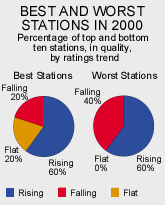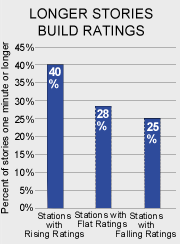Three years ago our design team of local TV news professionals told us that the most important mission for a newscast was to cover the entire community. The obligation — and what viewers wanted — was a full picture of the life of a place each day, from murders to museum exhibits, from fires to finance.
This might seem to run counter to the idea of targeting newscasts for the most appealing audiences, such as women and youth, and skipping unpopular topics, such as politics.

But the data suggest that targeting is a mistake. Viewers, it turns out, like breadth.
This year, stations with rising ratings covered notably more of their communities — about 10% more, according to our formula — than those whose ratings were falling.
The better a station does at covering the full spectrum of news and events in its community — and not ignoring certain topics because they’re difficult or unpopular — the more likely the station is to be gaining in ratings.
This same finding, at a slightly less pronounced rate, holds true over three years.
Story Length
The deepening discovery that viewers like breadth is matched by the finding over three years that people like depth.
Many stations try to create the illusion that they are covering the whole community by jamming more stories into the broadcast, like KNXV in Phoenix, which crams 27 stories, on average, into the usual 13 minutes of general news — about a story every 30 seconds.

But viewers hate it, and KNXV’s ratings are heading south. The data suggest that viewers like stations that air more long stories and minimize the number of very short stories.
- At stations building ratings, 37% of stories are a minute or longer. At stations falling in ratings, the figure is 24%.
- At stations rising in ratings, just 39% of stories are 30 seconds or shorter. At stations falling in ratings, 55% are.
- And stations losing ratings air almost twice as many super-short stories, less than twenty seconds long.
This finding, that viewers like depth and context, is not new. We found the same thing in our first year, and, to a lesser degree, in our second year. We will continue to watch. But over three years, the implication is getting clearer: too many short stories don’t provide the information or context viewers want. Regardless of the style of a broadcast, viewers want a significant number of stories to be long.
This may, ironically, explain why the famous experiment at Chicago’s WBBM, in which the newscaster Carol Marin produced a so-called serious newscast, hasn’t succeeded. The station tended to run a lot of very long stories — 27% were over two minutes. But it also tended to run a lot of very short stories — nearly half were 30 seconds or less — and it aired more stories each night than most newscasts. Rather than provide a lot of news in some depth, in other words, WBBM gave viewers a great deal about a few things and gave short shrift to almost everything else.
The lesson of WBBM’s difficulties may not be that people don’t like depth. To the contrary, they don’t like depth across the board sacrificed for the sake of just a few stories a night.




